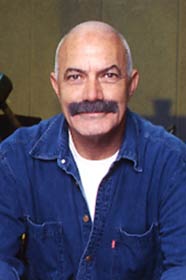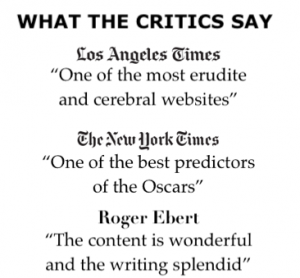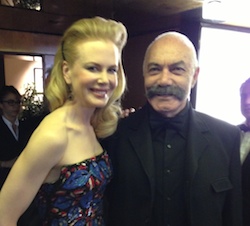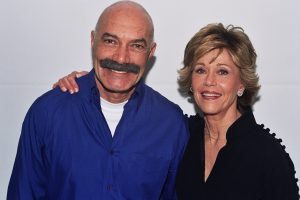Male-driven, all of these comedies are marked by mild juvenile humor and lack of any visual style. “School for Scoundrels” is particularly pedestrian from a technical standpoint; it almost feels like first film.
A loose remake of a 1960 British film of the same title (directed by Robert Hamer and starring Terry-Thomas and Alastair Sims), the comedy charts the journey of a shy, insecure NYC meter officer Roger (Jon Heder), who enrolls in a class for social misfits run by the mysterious Dr. P (Billy Bob Thornton)
One of the worst problems for comedy (more so than for drama) is when the filmmakers can’t decide what exactly is the target of their humor (the butt of their jokes), or specifically, whether their protagonist is bright or stupid, serious or comic, heroic or villain. In “School for Scoundrels,” the problem is exacerbated, because all of the above dimensions apply not to one character but to two leading ones, played by Heder and Thornton.
In fact, “School for Scoundrels” provides an extreme case of such a problem, to the point where every scene negates the previous one in tone and morale, until the movie literally self-destructs at the end, which happens to be on air…
A beleaguered meter officer, Roger is plagued by anxiety and low self-esteem. In order to overcome his feelings of inadequacy, Roger enrolls in a top-secret confidence-building class, taught by the suave yet brutal Dr. P. Aided by his assistant, Lesher (Michael Clarke Duncan), Dr. P. uses unorthodox (what else), often morally reprehensible and dangerous methods, including jungle combat exercises.
Committed to the cause of transforming his awkward students into “real” and secure men, any method would do for Dr. P: physical and verbal abuse, personal and public humiliation, underhanded tactics, and worst of all, lessons whose single motto is “Always Lie,” written in big letters on cards that the men take to–and read during–their dates!
But Dr. P guarantees results. If you apply his techniques to the letter, you’ll unleash the lion that’s been dormant inside you, literally; the movie is replete with paintings and I ages of aggressive lions in action.
The class consists of misfits–what else Walsh (Matt Walsh) is dying to move out of his mother’s basement; Diego (Horatio Sanz) is tired of being a punching bag for his hen pecker of a wife, and Eli (Todd Louiso) is a shy guy who’s just looking for female companionship, not sex (or so he says).
Gradually and predictably, Roger’s confidence grows, and he makes his way to the head of the class, even finding the courage to ask out his longtime crush, Amanda (Jacinda Barett, currently seen in similar role in “The Last Kiss”).
But Roger quickly discovers that star students have a way of catapulting Dr. P’s competitive side into high gear. Soon enough, the teacher sets out to infiltrate and destroy Roger’s personal and professional life. Nothing is off limits for Dr. P., not even the object of Roger’s affection.
Much of the action, such as it is, particularly the second and third reel, concerns Roger and Dr. P’s rivalry over the heart of Amanda, a graduate student/animal hospital volunteer; you can tell by her profession that she’s an ultra-sensitive femme (see below).
The movie reaches its nadir toward the end, when Roger tracks down one of Dr. P’s rebellious failures, a misfit hippie living in the woods (played by Ben Stiller in a physically weird manner). Their scenes together, like the whole movie, try to play it safe with (unfunny) gay jokes alternating with (unfunny) straight ones.
Upon discovering the scheme, and in order to show Amanda the true colors of Dr. P, Roger decides to rally his new friends (what else) and find a way to beat the master at his own game.
“School for Scoundrels” reunites Todd Phillips and Scot Armstrong, who co-wrote the funnier, albeit also rudimentarily made, comedies “Road Trip,” “Old School,” and most recently “Starsky and Hutch.” Here, they have constructed a bunch of adult (but immature) guys, who need guidance–for a variety of reasons. The class is for guys who are trying to get more or life, rather than just passively adjust to their mundane predicaments.
Roger begins as a shy, innocent youngster, who looks for help because he likes his neighbor Amanda, but he’s too scared to ask her out. This is just one problem of a whole life that’s been hard on himRoger’s co-workers often give him grief and his friends and family laugh and scoff at him. He’s the ultimate loser, a nebbish, though not the Woody Allen Jewish kind.
Heder, who was the star of the sleeper hit “Napoleon Dynamite” (a movie I didn’t champion), is a young actor who’s already hampered by mannerisms. Here, Heder does variation of that bumbling bright-fool role, which we also saw last year in the flawed romantic comedy, “Just Like Heaven.” Except that in “School for Scoundrels,” Heder is the lead, not supporting role, and we are stuck with Roger-Heder up close and personal.
High-concept also defines Dr. P, a role that was expressly written for Billy Bob Thornton. A hybrid of a genius self-help person and a scam artist, Dr. P tiresomely goes back and forth between these two facets. The role is meant to display the more polished side of Thornton’s penchant for sardonic wit, but in actuality, it does exactly the opposite.
In one of his more off-putting performances, Thornton, who looks physically strange, can’t find the arch of his role, due to the writing, and thus resorts to all kinds of actorish gimmicks borrowed from his previous, more successful turns. When he is ruthless, he recalls his turn in “Bad Santa;” when he is functioning as mentor treating his students as children, he’s like the instructor in “Bad News Bears,” a flop as a picture and not one of Thornton’s vantage roles either. Too bad, because Thornton’s range is impressively wide and he do well drama, comedy, and dramedy.
Michael Clarke Duncan, as Dr P’s assistant, sort of sergeant-at-arms, proves that he’s more naturally inclined for dramatic than comedic roles; most of his career thus far has been in dramas and this may is his (unsuccessful) effort to stretch.
Phillips and Armstrong have created one-dimensional, incoherent characters that come across as more stupid than shy or uncertain. Deep down, the movie may be not just stereotypical but also unintentionally misogynist. The two women in the film are the sensitive Amanda, who’s like the flipside to Dr. P’s, and the nasty raging bitch (Sarah Silverman, who doesn’t have a role so much as a series of one-liners).
“School for Scoundrels” could have been a satirical critique of what passes as sensitive masculinity these days, how courtship and romance have changed (or not) their course over the past decade. It doesn’t help that the film’s title is inaccurate, for the scoundrels here are not the students but their teachers.
As noted, the movie can’t decide whether to condon or to condemn Dr. P’s “educational methods,” so it does both in equal measures to middling and ultimately diminishing effects.










